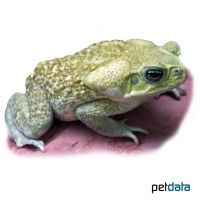Cane Toad (Rhinella marina)
| Cane Toad Rhinella marina | |
|---|---|
| Name | Cane Toad |
| Name Lat. | Rhinella marina |
| Synonym | Bufo marinus |
| Family | Bufonids |
| Family lat. | Bufonidae |
| Order | Frogs & Toads |
| Order lat. | Anura |
| Origin | America |
| Habitat | Wetlands |
| Diet | Live insects |
| Humidity | 70-80 % |
| Behavior | Predatory |
| Keeping | Individual, pair |
| Care Level | Moderate |
| Breeding | Simple |
| Housing | Semi-humid terrarium |
| Life Span | 10 years |
| Protection | No |
| Metric Units | |
| Size | 13-25 cm |
| Temperature | 22-28 °C |
| Housing Size | 60 x 60 x 50 cm |
| US Units | |
| Size | 5.1"-9.8" |
| Temperature | 72-82 °F |
| Housing Size | 25" x 25" x 20" |
Distribution and habitat
The original range of the crepuscular to nocturnal Aga toad extends from southern North America through Central America to northern South America, where they live in tropical and subtropical forests, but also in grasslands and cultivated land near water.
Maintenance
For 1 animal, the minimum area of the terrarium is 3,600 cm² with a minimum effective height (measured without substrate) of 40 cm. This corresponds to a base area of e.g. 60 x 60 cm, for 2 animals at least 70 x 60 cm. The terrarium should be placed in a quiet place without sunlight. Keeping several animals in one terrarium outside the mating season should be avoided, as the animals are cannibalistic.
They need a terrarium with a substrate of at least 20 cm of loose, absorbent, non-rotting substrate such as sand-peat mixture, coconut fibers or sphagnum moss with a drainage and a shallow watering place as large as possible, back and side wall coverings of e.g. natural cork boards as well as hiding places (stones, leaves, branches) and planting (e.g. Tradescantia, Ficus, Scindapsus, ferns). Potted plants that can be easily removed for cleaning are advantageous. At least once a day the inside of the terrarium must be finely sprayed with water (humidity), but a rain or mist system is better
| Temp. day: 22-28 °C | Temp. night: 20-22 °C | Humidity 70-80 |
The lighting duration must be 10-14 hrs. depending on the season. Daylight fluorescent tubes with low UV content are ideal.
Diet
They are voracious predators. According to their size, the food supply consists of live insects, such as grasshoppers, crickets, house crickets, etc., or a ready-made food for insectivores, supplemented with arachnids, worms and snails. Commercially available dog and cat food is also accepted. Food should be offered to adult animals 1-2 times a week, young animals must be fed daily. It is important to add minerals and vitamins regularly (e.g. by dusting the feed animals). The quality of the feed animals can be enhanced by feeding overripe fruit and honey water
A varied diet promotes health and prevents deficiency symptoms.
Reproduction and breeding
Both sexes are dark gray-brown to ocher in color. Males remain significantly smaller than females.
After the rainy season, the female ready to spawn is taken in the mating grip (amplexus) by the male and it attaches up to 20,000 eggs in spawning cords to water plants. Depending on the water temperature, the larvae (tadpoles) hatch after 1 to 6 days. After another 12 to 60 days the transformation (metamorphosis) is completed and the young toads leave the water.
Life expectancy can be over 10 years.
Important
Aga toads have been introduced to other tropical and subtropical areas, e.g. Australia, for pest control and pose a threat to native fauna due to their voracity. The venom glands above the eyes can secrete a poisonous secretion and spray it up to 30 cm away, which serves as a deterrent for predators. Special care must be taken when handling, as this venom can cause pain on contact with eyes and mucous membranes. Spawn and burbot also already have toxic repellents.
Before purchasing, a terrarium should be prepared that meets the species specific needs. Good ventilation without drafts is necessary, as well as equipment for measuring temperature and humidity. The lighting has to correspond to the species-specific day-night rhythm and should be placed in such a way that the animals cannot injure themselves. The terrarium should be locked in such a way that neither unauthorized persons can open it nor the animals can escape. Special attention must be paid to thorough hygiene and impurities must be removed regularly
Further literature can be found in your pet store
References
Text: Serena Werle; Image: petdata
Source: VDA & DGHT (2006): Haltungsrichtlinien für die Haltung von Anuren; ENGELMANN (2006): Zootierhaltung - Tiere in menschlicher Obhut: Reptilien und Amphibien, Harri Deutsch Verlag
- Gemäß § 21 Abs. 5 Tierschutzgesetz idgF
